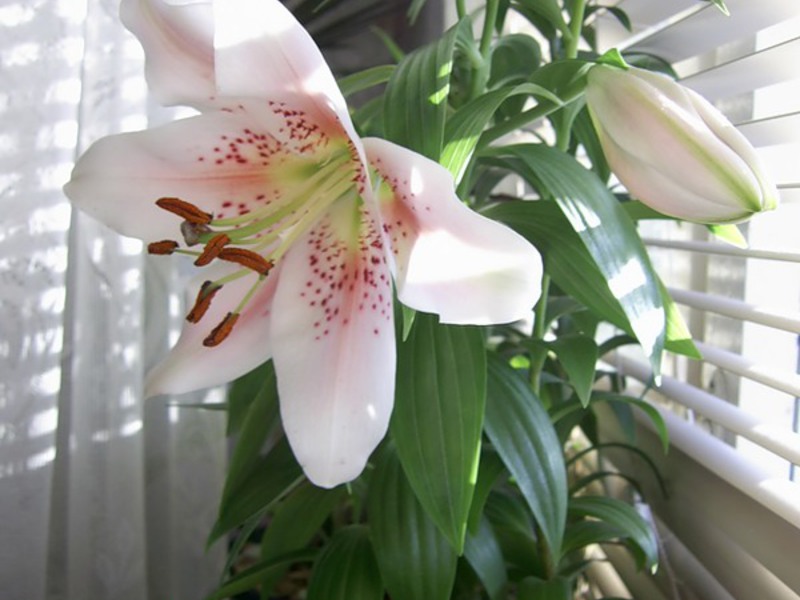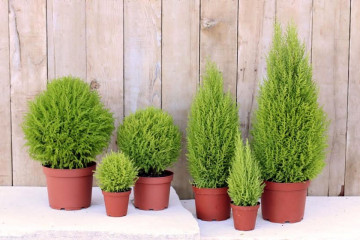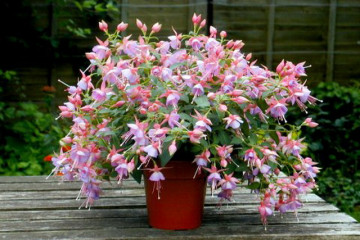Indoor lily or house lily in a pot - how to care
Content:
Among indoor plants, a special place is occupied by a flower with an extraordinary aroma - lily. Despite the short flowering period, it is readily grown. Lily not only harmoniously complements any interior, but is also a collectible.
Appearance and classification
Indoor lily includes a group of long-lived bulbous flowers. They belong to the Liliaceae family. Outwardly, they resemble ordinary herbaceous plants with an even and dense stem, the length of which is 70-185 cm. The leaves have a linear-lanceolate form with a width of 17-25 mm, and the maximum length reaches 25 cm. They are firmly held on the stem, there are no petioles. Home lily has unusual bulbs, consisting of several parts. They are round or oval in shape. There are naked or scaly species.
Popular varieties
The classification of the bulbous room lily is carried out depending on the structure:
- The shape of the flower resembles a wide-open bowl. Such petals are characteristic of gilded, beautiful and Chinese lilies.
- The petals are funnel-shaped and collected in a tube. Lily long-flowered, regal, Asiatic and amaryllis have similar lilies.
- The petals are bent away from the flower. This group cannot be called diverse. The size of such a plant is small - up to 55 cm, the flowers are also small - their radius does not exceed 3 cm. This includes the dwarf lily and Citronella.
Chinese lily
One of the most popular plant varieties is the Chinese lily. At first glance, it attracts attention with its large light white flowers with bright yellow stamens. The shape of its bulb is similar to that of a common onion. The Chinese variety is considered to be the most beautiful, as it most resembles a marsh water lily.
Asiatic lily
Among the hybrid varieties, this plant is the best known. Asiatic lily flowers have a rich and bright color: orange, lilac and pale pink. The color is unevenly distributed. One flower can have stripes and specks of different shades, as well as dark spots.
History of origin
The first descriptions of lilies are found even before our era. The flower got its name from the ancient Celtic word "li-li", meaning white. The plant was depicted in frescoes and vases in ancient Greece and Egypt. In Persia, flowers were used to decorate royal courts and lawns. In ancient Germanic mythology, the god of thunder and lightning Thor was depicted with a scepter in his hands, which was crowned with lilies. With the advent of Christianity, the plant began to be associated with the Virgin Mary as a symbol of purity.
How to care for a lily
House lily in a pot requires special care. Until the plant has buds, it should be sprayed with soft, slightly cool water. If desired, you can use growth stimulants, being careful not to touch the inflorescences. To prevent burns, flowers should be kept in the shade.
At the beginning of growth, a indoor lily flower needs a temperature of at least 10 degrees.Upon reaching a height of 10 cm, the landing should be transferred to a lighted place with a temperature not exceeding 16 degrees. In the future, it will take a lot of light and 25 degrees of heat to grow a healthy flower.
If the soil dries out, the flowers will simply stop growing. They need to be watered at least once every 3 days. Water can be taken from settled rain or warm boiled.
She needs light fertile soil (peat and humus in equal proportions), which must always be loosened after watering (it is not recommended to do this deeper than 6 cm). In no case should you touch the roots, otherwise the plant will be ugly. The use of special fertilizers is desirable after the planting of the bulbs, the release of flower stalks and flowering.
Since the plant often suffers from pests and parasites, it must be regularly sprayed with a spray bottle. This will scare off harmful insects. The liquid should be at room temperature.
Winter care
At the onset of the cold season, the lily goes into physiological dormancy. During this period, watering is minimized, and all feeding is stopped. The main thing is to provide the plant with a large amount of light. The flower pot must be placed on the south window.
Flowering period
The flowering period of the plant is approximately from the end of May to the end of August.
When a lily - a home flower - sheds a peduncle, it must be tied up. The best conditions for development at this time will be moist air and soil. To do this, you can spray the leaves of the plant with water using a spray bottle and regularly loosen the ground so that it is easier for air to penetrate to the roots.
Some of the buds are removed from a young lily. Wood ash will be a good top dressing. Most often, the plant blooms in summer, and in winter it is at rest, but if desired, the flowering time can be shifted. To achieve this, a dormant period is regulated.
As soon as the lily has faded, the peduncle must be cut off, and the container with the plant should be placed in a dry, dark place where it will not interfere. If you want to transplant a flower into a new soil, this time is the most suitable time. It is important to carefully monitor any bulbs that may start to dry out.
How to propagate
Often, homemade white lily and other varieties are propagated by young bulbs growing from one large one. After carefully separating them from each other, they are deepened into the ground by 3 cm. It is better to cover young seedlings with foil and sometimes ventilate.
Lilies can also be propagated by seed. It is a long and difficult process that will take a lot of time. The seeds can be purchased from a garden store or harvested from a wilted flower. It is recommended to plant them in early spring. The seeds must be carefully lowered into the soil to a depth of 1 cm.
It is better to use light soil as land. Also, the soil can be treated with a fungicide, and the bulbs with a growth biostimulant. There must be wooden sticks next to the plant so that the ascending stems have something to cling to.
If possible, river sand can be poured over the soil. The container with seeds must be covered with glass or transparent film. After the appearance of green leaves, the seedlings will need to be transferred to a bright place, for example, on a windowsill. When the first leaves are visible on the bulbs, they will need to be seated as carefully as possible in separate pots.
How to plant
Often, people wonder how it is easier to plant lilies? After the end of the flowering period, you must wait for the moment when the stems turn yellow and dry. In no case should they be cut off. As soon as the aboveground part is completely dry, watering must be stopped for two weeks.The lily bulbs can then be repotted. Leaving the same soil is not recommended, since it has already given up all the useful substances and will not allow them to develop a strong root system for the coming year.
First, take out a clod of earth and carefully disassemble it, carefully pulling out the bulbs. Large specimens should be rinsed under slightly warm and running water, then cut off the shoot 5 cm from the bulb. After that, everything needs to be put in a container and filled with potassium permanganate solution for half an hour. Now you need to let the bulbs dry in the fresh air for two hours. During this time, you can prepare sawdust and moss by placing them in a plastic bag. The bulbs are also put there. All contents are taken to the refrigerator or basement. This will keep the bulbs until they are planted.
It is better to plant bulbs in early autumn. Early spring is also good for this. If you plant a flower at this time, it will be easier for him to adapt to new conditions.
Why does not it bloom
There are only 4 main reasons why a room lily may not bloom:
- small bulbs;
- damaged kidneys;
- the presence of weeds or fungi;
- not the right place.
Often, flowering is suspended due to a drop in temperature from a comfortable 25 degrees to 10 and below. If the growth point was damaged when pruning the shoots, flowering will also not occur.
Sometimes the soil is covered with flowers. This means that the soil has not been steamed or treated with a fungicide. Carefully dig out the bulb and change the soil to a new one. The walls of the pot must also be treated with the drug.
Do not rely entirely on growth promoters. Filling the soil with minerals at the very beginning of flowering will be more than enough for bud development.
Also, it will not bloom if the place is too dark for it. You will need to transfer it to a more illuminated one.
Proper watering is essential for flowering. In no case should you water the lily with too cold or hot water.
Caring for a lily in a pot at home is quite difficult. However, her beauty is worth all this effort. With the right approach, the plant will delight for many years.




















